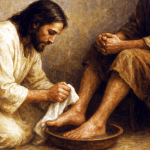Come, Follow Me for Individuals and Families: 1 and 2 Thessalonians
FEATURES
- Unmasking Halloween: Its Origins and Meaning by Daniel C. Peterson
- The Book of Mormon Includes These Doctrines That the Bible Leaves Out by Richard D. Gardner
- ‘Surviving Mormonism’ and it’s just … a church member showing up with cookies by Deseret News
- Conspiracy Theories: Why They Captivate Us and How They Divide Us by Steve Densley, Jr.
- Your Hardest Family Question: Can my controlling and angry husband change? by Geoff Steurer, MS, LMFT
- VIDEO: The Miraculous Preparation of Dallin H. Oaks by Meridian Magazine
- Weekend Movie Pick: Unbroken by Larry Richman
- Church Announces the Addition of 55 New Missions in 2026 by Meridian Church Newswire
- Jesus Didn’t Have an Office by Lynne Perry Christofferson
- The Halloween Scare by Daris Howard
-
Mental Health Minute: Becoming Self-Aware
-
VIDEO: The Miraculous Preparation of Dallin H. Oaks
-
President Holland, General Officers Invite Youth to Keep Looking Unto Christ
-
The Book of Mormon Includes These Doctrines That the Bible Leaves Out
-
Uruguay Marks 100 Years of The Church of Jesus Christ of Latter-day Saints with Celebration of Art and Faith
















Comments | Return to Story
Tom KunzOctober 16, 2019
One more thought. There is imagery in the word "strait" that I think helps to differentiate it from "narrow". One definition of a strait is a narrow waterway that connects to larger bodies of water on both ends. I believe the strait and narrow way, is the path that connects our premortal existence to our potential postmortal glory. Seen in this light, the strait way is the path that has both a beginning point and a destination. Both glorious in all aspects of the word.
Tom KunzOctober 16, 2019
Thank you for this wonderful article. I have two thoughts I would like to share to build upon what has been said. The first is in relation to the Iron Rod which is the Word of God. Perhaps the most important part of the Word of God is the still small voice that prompts us to do good. If we can learn to obey that voice, I believe we will never lose our way. The second is the word "cling". It is interesting that in Lehi's vision in 1 Nephi 8, those who were "clinging to the rod of iron" in verse 24, were ashamed in verse 25. However, in verse 30, those who came forth "continually holding fast to the rod of iron" did not seem to be ashamed and were not lost. I think there is something significant about "continually holding fast" vs. "clinging". Just as a child "clings" to its mother's apron, as soon as she moves, the clinging child loses their grip. "Continually holding fast" paints a more firm grasp of the rod than merely "clinging". I also like the relationship of this imagery to being "steadfast and immovable" as suggested at least four times in the Book of Mormon (Mosiah 5:15, 1 Nephi 2:10, 3 Nephi 6:14 and Alma 1:25.
ADD A COMMENT